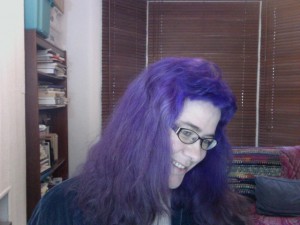The liturgical hair thing has not started all that well, though it could have been worse, I suppose.
I started by cutting the very ends of my hair off. These bits would have too much henna in them, I thought, to bleach well. Then came bleaching: well, I missed a bit, but also it became apparent that the henna goes rather further up my hair than I had thought.
When I went to put purple in my hair yesterday I found that some of the dye I bought wouldn’t go very far at all. The scissors came out again, and now I have a fringe (slightly too short), and the back and sides are even shorter. But I clearly didn’t cut enough off, because the ends haven’t taken the dye well at all. That’s fine for now, purple is dark and I can get away with a bit of variation in tone, but when I switch to White/Gold for Christmas, it won’t do to have orange at the ends. I may end up with an actual bob before December is out. So far there are 34 days of liturgical hair funded; you can add more at my JustGiving page.
I’d be lying if I said I’m thrilled about having to cut so much of my hair. I’m comforting myself with the rather tenuous thought that it’s appropriate, in a penitential season, to be doing this in preparation for the changes that will come with Christ in under a month.
In the wider cultural context of wall-to-wall carols, visits from Santa Claus, concerts, parties, chocolate and Christmas shopping, it can be hard to remember that Advent is a penitential season. (All right, maybe the Christmas shopping is an exception here.) And why would we expect it to be? Here we are, looking at the patriarchs, prophets, and so on, all foretelling the birth of this baby who shall be our salvation. A season of preparation, sure, we can get behind that, it’s worth having time to gear up for celebrations. But we know how this story “ends”: with the birth of a baby, always worth rejoicing. So why the penitence? Why is Advent historically also a period of fasting?
In short, the season isn’t only for preparing for the events of 25th December. We are also to be alert and awake, watching for the Second Coming of Christ. We don’t know when that will be, and we want to be ready. This isn’t just the department of those on the religious extremes of Christian culture, it’s part of the Apostles’ Creed: He will come again to judge the quick and the dead.
I’ll be honest: it makes me nervous. I’m not ready for Advent and Christmas, let alone the last judgement and the end of time. Secular Western culture isn’t ready either. The whole thing feels like some sort of nightmare, an extreme version of a house inspection with no notice. It is understandable that most people reject the idea that they should be afraid of someone who may not even exist. It is quite mainstream to shy away from our fears of inadequacy, our doubts about our own worth. Have another mince pie, it might be meaningless but they taste good and it’s cold outside.
But as Christians, we are not called to be “mainstream”: we are called to radical grace and love, a representation in this world of the grace of God and God’s perfect, overwhelming love for us. In the discomfort of looking ahead to events I don’t understand and cannot predict, I cling to the hope of that love. I hope beyond all reason that for all my fear and trepidation, I will find that the clarion call to judgement sounds like this:
“Wake up! You are loved!”

2 thoughts on “Liturgical Hair: Advent I”
Comments are closed.